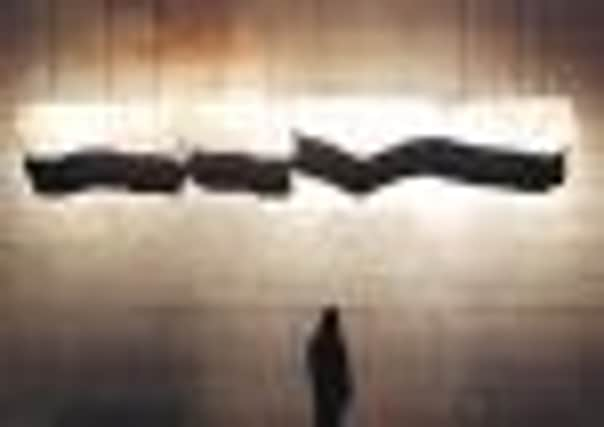Art review: Ian Hamilton Finlay - Tate Britain


A single work of art is spotlit and hung in chains from the ceiling: four enormous fragments of Bath stone, each apparently chipped and cracked yet mysteriously sturdy. The carved letters engraved on the stone read: “The world has been empty since the Romans.”
It feels as if the icy blast of history is whistling through the empty room. These are words attributed to Louis-Antoine de Saint-Just, the angel of death, the architect of the French revolutionary Terror. The Turner paintings next door, the Turner Prize show downstairs, which is packed with visitors, all are swept away in the fervour. This artwork seems to take on hundreds of years of culture and find it wanting.
Advertisement
Hide AdThis is the art of Ian Hamilton Finlay at its fiercest: somewhere between a call to arms and a threat. Standing outside any recent references to the times, it dares think in terms of the big sweep of history. And yet Finlay remains stubbornly relevant, part of our own age. A major installation of his work is showing in Brazil at the Sao Paulo Biennial, and this display of 24 works plus books, prints and cards has been timed to coincide.
It is six years since Finlay’s death. Born in 1925, in the Bahamas, he was surely the greatest artist to work in Scotland in the 20th century. It seems we are only beginning to digest his contribution: the words artist, poet, sculptor or gardener can’t quite sum it up.
Work continues to preserve his legacy at Little Sparta, the extraordinary poetic garden he created on a wind-blasted hill farm at Stonypath, Lanarkshire. Recently the Little Sparta Trust appointed a second gardener, George Gilliland, who has a background in gallery work and wrote his thesis on Finlay, to work with Ralph Irving on conserving and maintaining what is Finlay’s greatest art work.
This summer the Ingleby Gallery, which represents the artist’s estate, put on a delightful show, Twilight Remembers, with Little Sparta at its heart. Using Robin Gillanders’ photographs as a backdrop, it brought Finlay’s shepherd’s idyll into the heart of the city. Among the finds was a lost film, Carrier Strike, in which the Battle of Midway was reconstructed using an ironing board, some model aeroplanes and a hefty wad of cotton wool – a typical Finlay strategy, in that it brings the terrible events of history into the domestic sphere.
Indeed, Finlay’s attention to detail, his origins as a concrete poet, his interest in text, books and toys, can sometimes make his work seem diminutive and digestible. But one of the remarkable things about his art is how it always worked in two scales: carving a landscape by planting a woodland or digging a pond required the same attention as a tiny toy plane.
At Tate Britain, the Duveen Galleries are anything but diminutive, they are giant barrel-vaulted echo chambers and designed specifically for sculpture. So curator Andrew Wilson has wisely emphasised large scale where he can, and grouped smaller works into families in alcoves, or for printed matter, glass cases to bring focus. The emphasis is on the big Finlay theme of nature and culture, how both require husbandry, discipline and hard work.
Advertisement
Hide AdThey rely on a certain ruthlessness too and, like that quote from Saint-Just, Finlay did not shy away from using the themes of violence, conflict and terror that have shaped European culture. For Saint-Just violence was the necessary guarantee for Liberty, for Finlay the neo-classical ideal did not come without a price.
It’s a difficult theme for some of us to come to terms with. In a section of the exhibition devoted to smaller works, a bronze drum, spade and hoe sit next to a guillotine blade. A bronze machine gun is titled Flute. The angel of death turned out to be a keen and able musician. Finlay said of him: “The life of Saint-Just was a duet between the blade and the flute.”
Advertisement
Hide AdFinlay used the image of the gun and the blade, even the shocking image of the hand grenade, as much as in his own life he surrounded himself with trees and blades of grass. The temptation is often to emphasise Finlay as the pastoral shepherd, rather than the man who was shaped by his wartime service and, from his rural base, waged practical and cultural wars against figures he saw as complacent or establishment. Wilson does well to emphasise the starker end of his oeuvre, although at times it is a bleak experience.
There are counterpoints though, in a section dedicated to maritime works: a beautiful little assemblage of a glass float wrapped in net from 1971, the lovely text works of painted wood that read “Starlit Waters, Lead Us”. Among the texts Wilson has woven little stories: a series of jokes, texts and prints on the theme of lemon, and a section devoted to his beloved fishing boats.
Finlay lived at Little Sparta for 40 years, rarely leaving the garden where he bent nature to his own ideals. Many made the pilgrimage to Stonypath. The artist’s ideas and his work travelled and keep travelling.
Twitter: @MoiraJeffrey
• Ian Hamilton Finlay is at Tate Britain until 17 February. www.littlesparta.org.uk/